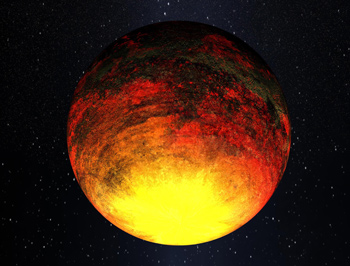[UPDATE (January 15, 2011): Mea culpa. It’s getting hard to keep up with all the exoplanets being found now, and a few folks have let me know that the planet CoRoT 7b, while bigger than Kepler-10b, is also likely solid and not a gas giant. In fact, they’re pretty similar in size and distance from their respective stars! So this planet is not the first one of its kind to be found, though still very cool and exciting. My apologies for this, and next time I write about planets I’ll make sure to go through the database first!]
Astronomers have just announced the discovery of the first planet orbiting another star that is unequivocally not a gas giant: it must be a very dense, rocky-metallic object not much bigger than the Earth!
 The planet, discovered by the orbiting Kepler telescope, is called Kepler-10b. The star (Kepler 10) is roughly the same mass and temperature as the Sun, and is located over 500 light years away.
The planet, discovered by the orbiting Kepler telescope, is called Kepler-10b. The star (Kepler 10) is roughly the same mass and temperature as the Sun, and is located over 500 light years away.
The planet was detected because it passes directly between us and the star as it orbits. When it does that, it makes a mini-eclipse, blocking a bit of light from the star. By knowing how big the star is and how much light is blocked, the size of the planet can be measured (the bigger the planet, the more light is blocked). In this case, Kepler-10b is only about 1.4 times the diameter of the Earth, making it the smallest exoplanet ever found!
However, there’s more. The planet’s gravity tugs on the star as it orbits, so as the planet makes a big circle around the star, the star makes a little circle in response (I like to use the analogy of a father dancing with his small daughter; as he swings her around she makes a big circle around him and he makes a little circle, because he’s much more massive than she is). As the star moves slightly toward and away from us we can measure the change in velocity using the Doppler shift, and that in turn tells us the mass of the planet. It turns out Kepler-10b is a lot more massive than the Earth, tipping the scales at 4.6 times the Earth’s mass.
So it’s not terribly earth-like; if you stood on its surface you’d weigh almost 2.5 times what you do now!
Even worse, it orbits extremely close in to its star, circling over the star’s surface at a distance of roughly 3 million kilometers (1.8 million miles) – amazingly, it takes less than an Earth day to make one circuit. But being that close to a star comes at a price: the surface temperature of the planet must be several thousand degrees! So yeah, you’d weigh more there, but not for long. You’d burn through those extra calories pretty rapidly. Literally.
And even worse, it’s almost certain the planet is tidally locked to its star, meaning it always shows one face to the star (like the Moon does to the Earth). So the side facing the star is scorching hot and probably glowing brightly with heat, as shown in the artist’s depiction above. This is truly a scary, hellish world.
I’ve seen a lot of reports already calling the planet “solid”, but I think it’s clear that it must actually be molten. I I think the reports are trying to distinguish it from the usual hot super-Jupiters found around other stars, planets that are bloated gas giants. Kepler-10b is certainly much smaller and therefore not a gas giant.
So this planet is not even close to being earth-like and habitable, but it’s still the lowest-mass and smallest planet ever found orbiting a sun-like star. This is a huge milestone, because it shows without doubt that Kepler has the potential to fulfill its mission of finding a truly earth-like planet orbiting a distant star. How long will it be before we see one of those? If they exist and Kepler can spot one it’ll still be a couple of years, sadly, but the good news is we should be able to see it. And that’s exciting enough for me for now.
Image credit: NASA
Related posts:
- Gallery of exoplanets: real images of alien worlds
- Kepler works!
- Sunburned planets turns hot face away from star